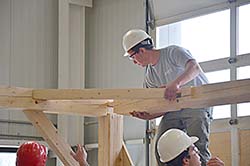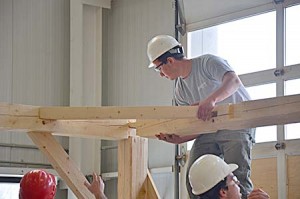

copyright the Chronicle April 15, 2015
by Nathalie Gagnon-Joseph
DERBY — The smell of fresh wood and the noise of tools at work greeted anyone walking into North Country Career Center’s (NCCC) woodshop class on Thursday. Students were hard at work at the Harold J. Haynes Memorial Land Lab, assembling a timber frame cabin — designed by someone who’s been dead for over 150 years.
“When complete, the city of Newport will have a replica of Thoreau’s cabin,” said Ryan Anderson, an English teacher at North Country Union High School (NCUHS).
The effort to recreate Henry David Thoreau’s famous cabin has been an interdisciplinary affair, involving the English, video productions, building trades, and natural resources students at NCUHS and NCCC.
On Thursday, students raised the timber frame cabin under the guidance of several teachers and Makaio Maher of Glover, who owns a specialty building company, Green Timber Works.
“This was a practice,” Mr. Maher said.
Now that the builders know all the cabin’s pieces fit together, the students will take down the structure and raise it again at its final resting place, which will be someplace in Newport.
“The cabin will become an outdoor classroom for the high school, the career center, Turning Points, and Prouty Beach summer camps,” said Mr. Anderson. “We hope many locals and tourists alike will visit this site, spreading the teachings of Thoreau.”
Mr. Thoreau’s writings are iconic to American literature and philosophy, and recreating the cabin was put into motion by Mr. Anderson.
His own junior year English teacher had brought him to visit Walden Pond in Massachusetts, where Mr. Thoreau lived for two years in his legendary cabin. Mr. Thoreau’s writings were a strong influence in Mr. Anderson’s life from then on, one he wanted to share with his own students at NCUHS.
“For the past six years, I had been contemplating a plan to get my students there, until I realized I could bring part of the experience here,” Mr. Anderson said.
He recruited the help of natural resources teacher Sam Nijensohn and building trades teacher Tom Rooney to bring his idea to life. Mr. Rooney got a grant to hire Mr. Maher as a consultant.
“I am always looking for ways to make learning interesting and relevant for my students,” he said. “I also value hands-on activities, which is not always easy when studying literature and composition.”
Mr. Anderson’s English seniors coordinated the project. They are in charge of reading, understanding, and explaining Mr. Thoreau’s texts; researching; contacting supporters; writing proposals to Newport’s City Council for the space to install the cabin; and writing e-mails and articles for publication and grants. So far, they’ve received a $1,000 grant and submitted an article to the Vermont Forest Association, Mr. Anderson said. Video productions students are in charge of documenting the entire process.
Although everyone pitched in on Thursday, Mr. Nijensohn’s natural resources students took a back seat. They had done their part beforehand, choosing the trees to fell in the woods around the lab, and milling them into the various log sizes and shapes required.
They used tamarack to make the floor of the cabin because it is rot-resistant and strong. The rest of the cabin’s pieces were made from northern softwoods like the balsam fir or the red spruce.

The process taught students to become good stewards of the forest, Mr. Nijensohn said.
Students picked trees based on their pathological rotation, which is the age at which the tree needs to be cut to ensure the forest’s health, Mr. Nijensohn said.
After picking the trees, the students felled them manually and used a tractor to drag them back to a clearing behind the lab, to be cut to the right size.
“There were some funky cuts,” Mr. Maher said about the design for the cabin replica, which he found online.
Manual felling can take time, but loggers can choose the tree to cut more carefully, and without specialized heavy machinery, there’s no need for a path to the tree.
“There’s the potential for better benefits to the forest with manual felling,” said Mr. Nijensohn.
The cabin measures ten by 16 feet, with eight-foot walls, not including the peaked roof.
Putting the timber frame cabin’s parts together looked a lot like making a puzzle. After notching and chiseling, building trades students assembled the cabin’s beams by inserting tenons, wood tongues on the end of a beam, into mortises, a hole in another piece of wood shaped like the corresponding tenon. All the pieces were organized and shaped beforehand.
“The craft hasn’t changed a lot,” Mr. Maher said.
The only things the students didn’t make themselves were the screws, the pegs, and the cedar shingles that will make up the roof.
Mr. Maher showed the students the old way of building using new methods, he said. Where the students used an electric drill to bore holes into the logs, before, they would have used a drill with two hand cranks. But some of their tools, like the mallet and pegs, haven’t changed much, if at all.
There are buildings made using the timber framing method everywhere in Vermont, especially barns, Mr. Maher said. Many are sagging because they haven’t been taken care of, but they have still lasted hundreds of years.
Building timber frame barns went out of favor when the U.S. Food and Drug Administration decided milking parlor floors had to be made of concrete, Mr. Maher said.
Now timber frame structures are fashionable. In fact, Mr. Maher’s specialized business mostly builds new homes.
A house’s frame is usually made using two-by-fours and a nail gun, but timber framing is more work, more solid, and more beautiful, Mr. Maher said.
“It’s been a fun project,” said Omer Roberge, who assisted the building trades class. “This is different. It’s a lot stronger. It’s a specialty. It looks good right off because you see the exposed wood. It’s a great way to build a home.”
Eighteen-year-old Nickolas Sicard of Troy takes the building trades class.
“I’d build a house like this,” he said. “I think it’s pretty strong.”
His favorite part of the process was seeing the work coming together as they pulled up the walls and built the roof.
Dakota Green of Troy, 18, is a forestry student. He wants to become a logger. He would build himself a timber frame house if he had the skill, he said, but he thought the process was a little too time-consuming.
The next step is to finalize where the cabin will be installed, and prepare the site using stones for the cabin’s foundations to sit on, Mr. Maher said.
Mr. Anderson’s students are proposing a site across from the American Legion just off the recreation trail, but some people are worried about vandalism, Mr. Maher said.
The rafters were scheduled to go into the structure in another building session, said Mr. Maher, who expects everything to be finished sometime in May.
As the students piled onto a school bus to return to their other classes, the teachers nailed an evergreen branch to the cabin’s gable.
It’s a sign of respect for the forest, said Mr. Maher, thanking it for the wood used, and it brings good luck.
contact Nathalie Gagnon-Joseph at [email protected]
For more free articles from the Chronicle like this one, see our Featuring pages. For all the Chronicle’s stories, subscribe:
Print subscription
Annual online subscription
Short-term online subscription







